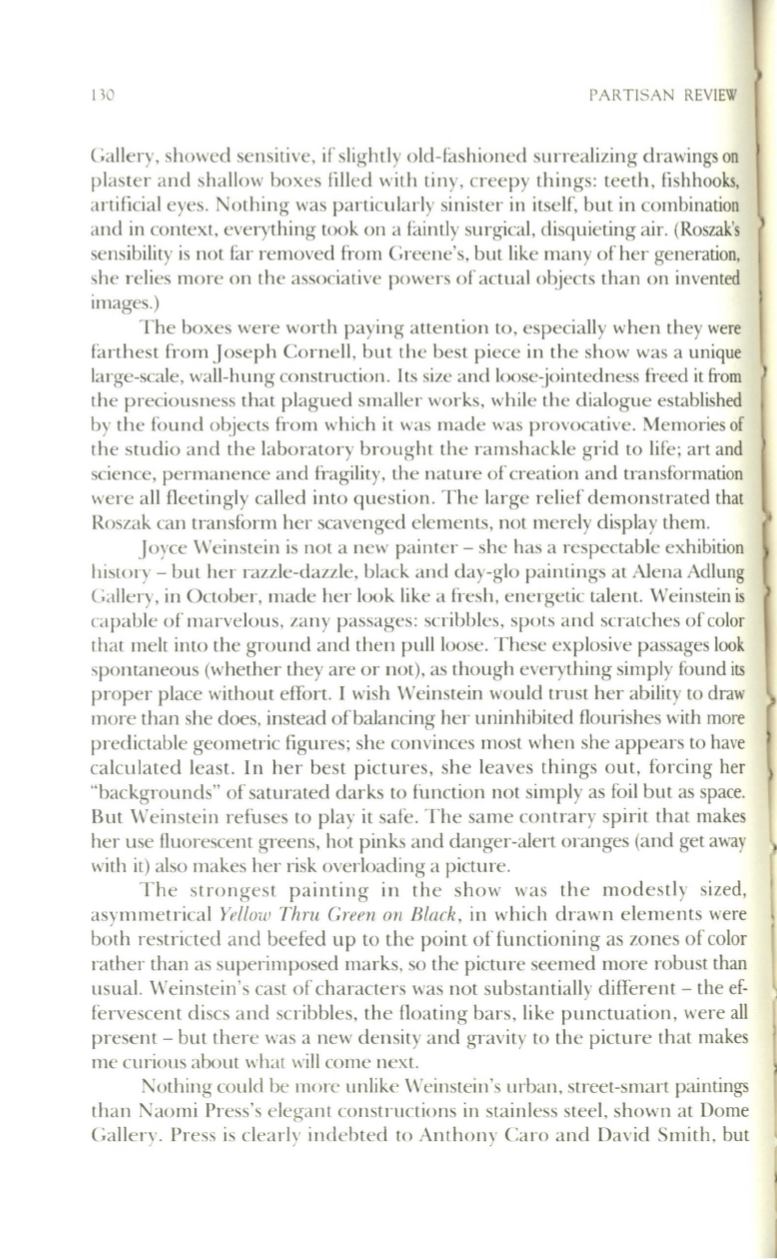
1>0
PARTISAN REVIEW
Callery, showed sensitive, if slightly old-fashioned surrealizing drawings on
plaster and shallow boxes filled with tiny, creepy things: teeth, fishhooks,
artificial eyes. Nothing was particularly sin ister in itself, but in combination
and in context, everything took on a faintly surgical, disquieting air. (Roszak's
sensibility is not far removed from Greene's, but like many of her generation,
she relies more on the associative powers of actual objects than on invented
images.)
The boxes were worth paying attention to, especially when they were
farthest from Joseph Cornell , but the best piece in the show was a unique
large-scale, wall-hung construction.
Its
size and loose-jointedness fi-eed it from
the preciousness that plagued smaller works, while the dialogue established
by the found objects from which it was made was provocative. Memories of
the studio and the laboratory brought the ramshackle grid to life; art and
science, permanence and fragility, the nature of creation and transformation
were all fleetingly called into question. The large relief demonstrated that
Roszak can transform her scavenged elements, not merely display them.
Joyce Weinstein is not a new painter - she has a respectable exhibition
history - but her razzle-dazzle, black and day-glo paintings at Alena Adlung
Callery, in October, made her look like a fresh, energetic talent. Weinstein is
capable of marvelous, zany passages: scribbles, spots and scratches of color
that melt into the ground and then pull loose. These explosive passages look
spontaneous (whether they are or not), as though everything simply found its
proper place without effort. I wish Weinstein wou ld trust her abi lity
to
draw
more than she does, instead of balancing her uninhibited flourishes with more
predictable geometric figures; she convinces most when she appears to have
calculated least. In her best pictures, she leaves things out, forcing her
"backgrounds" of saturated darks to function not simply as foil but as space.
But Weinstein refuses to play it safe. The same contrary spirit that makes
her use fluorescent greens, hot pinks and danger-alert oranges (and get away
with it) also makes her risk overloading a picture.
The strongest painting in the show was the modestly sized,
asymmetrical
Yellow Thru Creen
OIL
Black,
in which drawn elements were
both restricted and beefed up
to
the point of functioning as zones of color
rather than as superimposed marks, so the picture seemed more robust than
usual. Weinstein 's cast of characters was not substantially different - the ef–
fervescent discs and scribbles, the floating bars, like punctuation, were all
present - but there was a new density and gravity to the picture that makes
me curious about what will come next.
Nothing could be more unlike Weinstein's urban, street-smart paintings
than Naomi Press's elegant constnlCtions in stainless steel, shown at Dome
Callery. Press is clearly indebted to Anthony Caro and David Smith, but


